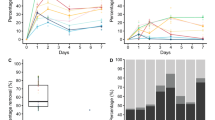Abstract
Ability for selective extraction of copper and zinc from zinc concentrate using association of chemolithotrophic bacteria was investigated. In the presence of bacterial association, the rate of leaching of zinc, copper, and iron was increased 3-fold, 4–5-fold, and 2-fold, respectively. The results indicate the maximum dissolution rate for zinc, then followed by copperand iron. It was revealed that addition of Fe3+ 2 g/l resulted in reduction of iron leaching and in 3-fold increase of leaching rate of copper at constant dissolution rate of mineral zinc. It is suggested that the intensification of copper leaching is connected with the activity of sulfur-oxidizing bacteria able to activate the mineral surface via elimination of passivation layer of elemental sulfur. It was concluded that sulfur-oxidizing bacteria play a significant role in copper leaching from zinc concentrate. A unique strain of mesophile sulfur-oxidizing bacteria was isolated from leaching pulp of zinc concentrate; in the perspective, it may serve as efficient candidate for performing of selective extraction of copper from zinc concentrate.
Similar content being viewed by others
References
Aloyan, P.G., Aloyan, G.P., Davtyan, A.A., Markosyan, A.A., Arutyunyan, T.M., and Stepanyan, I.G., Metally: Chernye, tsvetnye, blagorodnye, redkie metally i redkie zemli (Metals: Ferrous, Nonferrous, Precious, Rare Metals and Rare Earths), Yerevan: GEOID, 2006.
Adamov, E.V. and Panin, V.V., Biotekhnologiya metallov (Biotechnology of Metals), Moscow: MISiS, 2003.
Carranza, F., Carcia, M.J., Palentia, I., and Pereda, J., Hydrometallurgy, 1990, vol. 24, no. 1, pp. 67–76.
Carranza, F., Iglesias, N., Romero, R., and Palencia, I., FEMS Microbiol. Rev., 1993, vol. 11, nos. 1–3, pp. 129–138.
Fowler, T.A. and Crundwell, F.K., Appl. Environ. Microbiol., 1999, vol. 65, no. 12, pp. 5285–5292.
Harneit, K., Goksel, A., Kock, D., Klock, J.-H., Gehrke, T., and Sand, W., Hydrometallurgy, 2006, vol. 83, nos. 1–4, pp. 245–254.
Sandstrom, A. and Petersson, S., Hydrobiology, 1997, vol. 46, nos. 1–2, pp. 181–190.
Rehman, M., Anvar, M.A., Iqbal, M., Akhtar, K.., Khalia, A.M., and Ghauri, M.A., Hydrometallurgy, 2009, vol. 97, nos. 1–2, pp. 1–7.
Giaveno, A., Lavalle, L., Chiacchiarini, P., and Donati, E., Hydrometallurgy, 2007, vol. 89, nos. 1–2, pp. 117–126.
Nagdalyan, S.Z., Kocharyan, E.M., and Vardanyan, N.S., Biol. Zh. Arm., 2009, vol. 61, no. 1, pp. 18–23.
Vardanyan, N.S. and Nagdalyan, S.Z., Appl. Biochem. Microbiol., 2009, vol. 45, no. 4, pp. 401–405.
Biogeotekhnologiya metallov. Prakticheskoe rukovodstvo (Biogeotechnology of Metals: A Practical Guide), Karavaiko, G.I., Rossi, J., Agate, A., Grudev, S., and AvakyanEds, Z.A., Eds., Moscow: Tsentr Mezhd. Proektov GKNT, 1989.
Reznikov, A.A., Mulikovskaya, E.P. and Sokolov, I.Yu., Metody analiza prirodnykh vod (Analytical Methods for Natural Waters), Moscow: Nedra, 1970.
Olson, G.J., Brierley, J.A., and Brierley, C.I., Appl. Environ. Microbiol., 2003, vol. 63, no. 3, pp. 249–257.
Promyshlennaya mikrobiologiya (Industrial Microbiology), Egorov, N.S., Ed., Moscow: Vysshaya shkola, 1989, pp. 634–660.
Adelson De, S., Pablo, S.P., and Versiane, A.L., Miner. Engin., 2007, vol. 20, no. 6, pp. 591–599.
Shi, S-Y., Fang, Z-H., and Ni, J-R., Proc. Biochem. Soc., 2006, vol. 41, no. 2, pp. 438–446.
Deveci, H., Akcil, A., and Alp, I., Hydrometallurgy, 2004, vol. 73, nos. 3–4, pp. 293–303.
Kai, T., Suenaga, Y-I., Migita, A., and Takahashi, T., Chem. Engin. Sci., 2000, vol. 55, no. 17, pp. 3429–3436.
Author information
Authors and Affiliations
Corresponding author
Additional information
Original Russian Text © N.S. Vardanyan, A.K. Vardanyan, 2011, published in Prikladnaya Biokhimiya i Mikrobiologiya, 2011, Vol. 47, No. 5, pp. 566–571.
Rights and permissions
About this article
Cite this article
Vardanyan, N.S., Vardanyan, A.K. Selective extraction of metals from zinc concentrate by association of chemolithotrophic bacteria. Appl Biochem Microbiol 47, 515–519 (2011). https://doi.org/10.1134/S0003683811050140
Received:
Published:
Issue Date:
DOI: https://doi.org/10.1134/S0003683811050140




